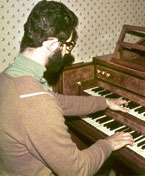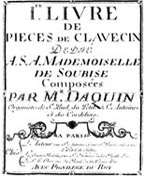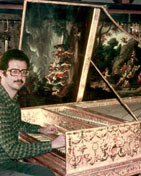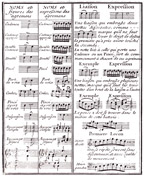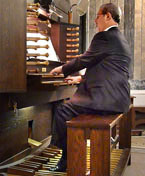Excerpts from the book
PROLOGUE
Countless writings by outstanding Baroque-era musicians throughout one and a half century, from Mersenne to Quantz, coincided in assigning to ornamentation the utmost importance for a correct, sensitive and expressive music making. …
1.1 THE REDISCOVERY OF BAROQUE ORNAMENTATION
… Concerts featuring harpsichords had taken place as far back as in 1832 in Paris and 1836 in London. ... The modern Early Music Movement (EMM) enters its full development in the 1960s with the celebrated recordings on period instruments by Nikolaus Harnoncourt conducting the Concentus Musicus, as well as Gustav Leonhardt on the harpsichord, often together with his Consort ... The EMM continues in the 1970s with the memorable recordings of Kenneth Gilbert at the harpsichord, Christopher Hogwood conducting The Academy of Ancient Music, and dozens of other soloists and conductors … mostly with very authoritative rendering of ornaments based on the sources.
Unfortunately, soon Prof. Frederick Neumann questioned the very foundations of present-day knowledge about the Baroque performance of ornaments: his treatise achieved great diffusion, lasting to this day. A few negative reviews followed: find here a full rebuttal …
… During the 1980s and 1990s the EMM continued in full drive with many new remarkable recordings, for example by the English Baroque Soloists directed by John Eliot Gardiner.
… yet another attack was perpetrated. … Richard Taruskin vehemently upheld that present-day musicology and early-music performance practice just had “a thin veneer of historicism”, hardly scratching the surface of historical performance customs; therefore modern attempts at an authentic rendering … were conceptually misleading. By dismissing as negligible the vast present knowledge about Baroque musical customs, Taruskin actually promoted neglect if not plain ignorance.
... This book is meant to be a homage to the brave first-class performers who work hard at keeping the Early Music Movement alive. Hopefully it will be a helpful tool for young students and amateurs.
1.2 THE ESSENTIAL ORNAMENT
… After the early Baroque era ... ornaments were considered of the utmost importance, being crucial in order to produce “Expression … in Good Taste” (Geminiani, 1749) ... In the Baroque era the essential ornament became mainly a French manner, soon adopted in German and Dutch lands, where composers often wrote pieces following French style and dance forms. This said, essential ornaments were also in use (although much more sparingly) in Italy and other countries, including the Iberian Peninsula where … they were performed with different conventions.
1.3 THE FREE EMBELLISHMENT
The free embellishment consists of added fast notes in the score, mostly in either of two ways: DIVISION … and EMBELLISHMENT …
1.4 IMPROVISED ORNAMENTATION
… in the early music eras, and very especially in slow movements in the Italian style, performers would often read a score and play from it adding ex-tempore ornamentations: these could be either essential ornaments or free embellishments …
2.3 A LIST OF THE SOURCES
For the preparation of PART II of this book, a selection of the extant Baroque tables and text descriptions has been surveyed. This is a list of our 36 main sources: …
3.3 ORNAMENT INTERVALS
Essential ornaments move by diatonic degrees. … These principles are not always easy to apply …
MAJOR TONALITIES: … MINOR TONALITIES: … ACCIDENTALS: … ENHARMONIC INSTRUMENTS: …
4.1 THE MORDENT’S SIGN
From the Middle Ages to the very early Baroque eras, often the same sign was used for both mordents and trills. … BACH’S SIGN: IS IT A MORDENT OR A TRILL WITH TERMINATION? …
4.2 THE MORDENT’S REALISATION
ON-THE-BEAT AGAINST BEFORE-THE-BEAT REALISATION AND OTHER CONUNDRUMS. In spite of the wealth of extant Baroque ornament tables (with largely consistent information) and associated musical scores, many important details about Baroque ornament realisation were the subject of heated discussions in the 20th century. ...
5.2 THE UNMARKED TRILL
Sometimes an ornament is missing from the score. … this is particularly frequent for the trill, because the Baroque composer expects the musician to play an unmarked trill … whenever any of the following situations occurs: … Examples abound in the works of J. S. Bach and Handel. Let us see but a few …
7.7 THE COULÉ DE TIERCE OR PASSING APPOGGIATURA
… Therefore, again pace late Quantz and Leopold Mozart, the isolated pre-beat coulé …
8.4 PERMANENT ARPEGGIO
… Most present-day harpsichordists play all the slow movements with a permanent arpeggio throughout. … we shall scrutinise this relatively-recent permanent-arpeggio manner, collating it with the historical record. ...
12.2 BAROQUE WOODWINDS
... There were many additional details associated with playing techniques peculiar to each instrument. On the BAROQUE TRANSVERSE FLUTE a notorious difficulty is to distinguish the F natural, always too sharp, from the F sharp, always too flat. Normally the player corrects this issue with embouchure and/on slightly turning the flute around, but this is not possible when playing a shake.
For a semitone shake …
For a whole tone shake …
13.1 EMBELLISHMENT OR JUST FAST NOTES?
The beginner may believe that any Baroque piece full of fast passages is an example of embellishment. This is far from being the case. Actually:
- There are very fast passages that are not embellishments.
- There are relatively slow passages that are embellishments. …
14.5 QUANTZ ON ORNAMENTATION FOR THE ADAGIO
Quantz ... precedes the … Adagio with different comments that are reproduced below, suitably abridged:
- Playing a solo as written is inexpert and boring, mainly in slow movements. …
- The Adagio should not be overloaded with ornaments. ...
At this point, the punctilious Quantz appears to be less than consistent …
Let us mitigate this conundrum by concluding that Quantz had a very legitimate worry: …
16.1 THE CONUNDRUM OF THE SOURCES
… “Just read the original sources!” is ... preached about extant treatises and documents that explain all sorts of Baroque interpretation manners, ornamentation included. Here matters are ... treacherous:
- Sources are written in the local musical jargon …
- Sources use particular ancient conventions …
- … customs described may be in disagreement with prevalent usage ...
- Collating different sources may show contradictions …
... Modern scholarship has scrutinised the evidence and produced, for the benefit of the present-day performer,
most-likely results ...
___________________________________________________________________________________
These are reduced screenshots of some pages from the book:
